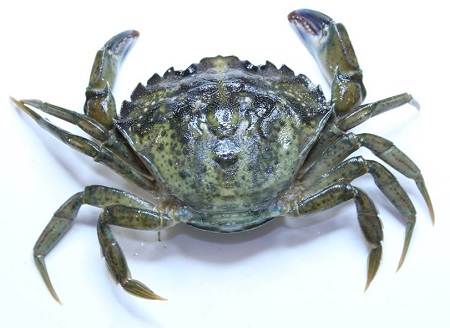European shore crab (Carcinus maenas) is an aggressive predator. It outcompetes native species for food and space.
What to look for
Features:
- green or brown shell with pale orange underside
- 5 spines on each side of eyes
- back legs are sharp and slightly flattened at tips
- no swimming paddles on back legs
- smooth shell, up to 7cm wide.
Where to look
Look in or around:
- burrows in mud or sand
- mangroves
- rocky reefs
- shore line.
Likely habitats include:
- hard and soft surfaces
- shores and shallow waters, up to 60m deep.
Established pest in parts of New South Wales, Victoria, Tasmania and South Australia.
Similar native species
These native species look similar to European shore crab. They do not need to be reported.
Sand crab (Ovalipes australiensis)
Features:
- plain grey shell
- 2 distinctive purple spots towards rear
- swimming paddles on back legs
- shell up to 10cm wide.
Habitat:
- burrows into sand
- shores and shallow waters, up to 60m deep.
Known locations include Queensland, New South Wales, Victoria, Tasmania, South Australia, and Western Australia.
Paragrapsus species
Features:
- yellowish brown shell with dark red spots
- 3 spines on each side of eyes
- first walking legs have felt patch on inner side
- shell up to 4.5cm wide.
Habitat:
- sheltered areas
- shores and shallow waters
- under stones and burrows into mud.
Rough rock crab (Nectocarcinus integrifons)
Features:
- black pincers
- fine hairs covering shell
- no swimming paddles on back legs
- shell up to 8cm wide.
Habitat:
- hard and soft surfaces
- sheltered seagrass beds
- shores and shallow waters, up to 15m deep.
Known to occur from Fremantle, Western Australian to Port Stephens, New South Wales, and Tasmania.
Report it
See something unusual? Report it. Even if you’re not sure.
If you see something you think is a pest:
- note the exact location (screenshot your map app or enable photo geotagging on your phone)
- take a photo (use something for size reference, like a coin or note)
- contact your state or territory authority.
Stop the spread of marine pests
Start with these simple steps:
- Inspect and clean your boat or yacht. Make sure you check hard to reach areas.
- Treat the hull of your boat or yacht regularly.
- Clean and dry your fishing and diving gear after every use.
How you can stop the spread of marine pests.
Your location
The map shows known pests and pests to look for around Australia.





